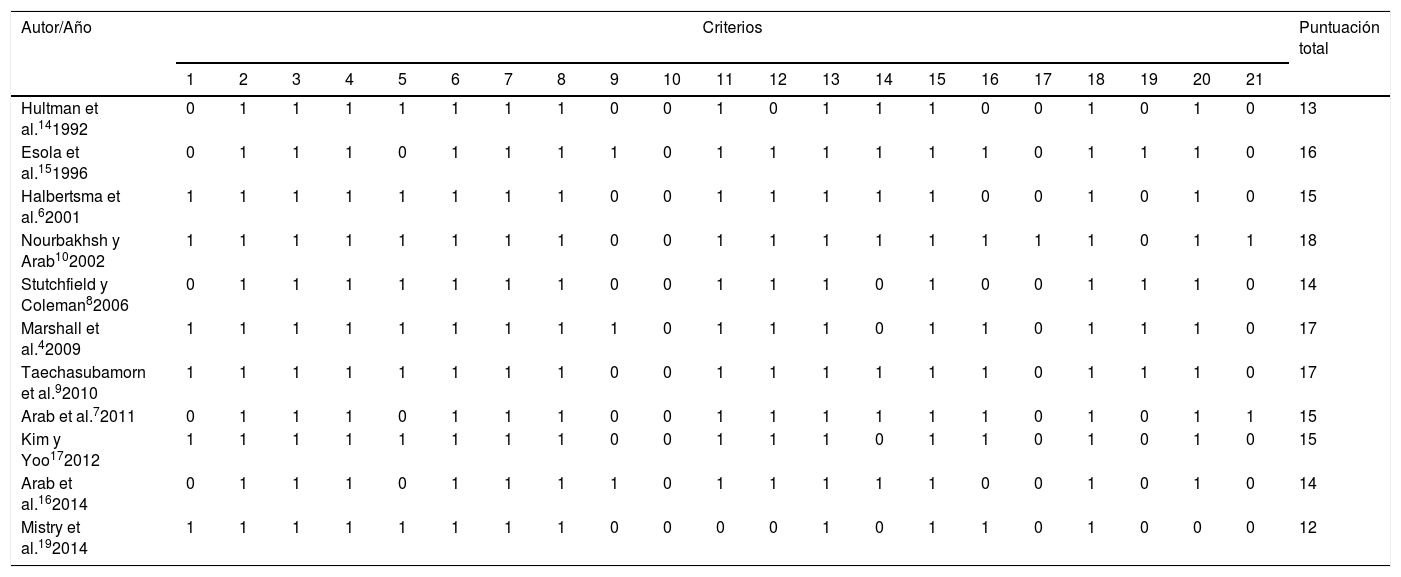El 80% de la población ha experimentado dolor lumbar (DL). Mundialmente, el DL causa un impacto social y económico enorme. Dentro de las deficiencias relacionadas con la presencia de DL se encuentra el acortamiento de los músculos isquiotibiales (ISQ), los que, por su inserción sobre la tuberosidad isquiática pueden generar rotación de la pelvis hacia atrás y rectificar la lordosis lumbar, lo que sobrecarga la región lumbopélvica, favoreciendo la aparición de DL. Biomecánicamente se ha descrito el posible vínculo entre el acortamiento de los ISQ y el DL, con literatura no concluyente. El objetivo del presente artículo es: analizar sistemáticamente la literatura y establecer si existe relación entre las retracciones musculares de los ISQ y la presencia de DL.
Materiales y métodosSiguiendo las recomendaciones de la declaración PRISMA, se realizó la búsqueda de artículos en diferentes bases de datos, entre agosto y septiembre de 2018, aplicando los criterios de inclusión. Después de la depuración y búsqueda secundaria se evaluó la calidad metodológica de los artículos seleccionados, por medio de la Declaración STROBE (Strengthening the Reporting of Observational Studies in Epidemiology).
ResultadosCiento dos artículos fueron detectados en la búsqueda en las bases de datos, de los cuales 12 cumplieron con la calidad metodológica para ser incluidos en la revisión, el 33,3% con muy buena calidad y el 66,7% de buena calidad. Las pruebas empleadas para evaluar la longitud de los ISQ en los estudios, fueron la elevación de la pierna recta y la extensión activa de rodilla. Ocho de los artículos analizados encontraron diferencias en la longitud de los ISQ en personas con DL y el grupo control y 4 no hallaron diferencias.
ConclusiónNo se encuentra soporte científico suficiente para establecer si el acortamiento de los ISQ es una causa o una consecuencia del DL, por lo cual se requieren de estudios con mayor rigor metodológico.
Eighty percent of the population has experienced low back pain (LBP). Worldwide, LBP causes huge social and economic impact; among the deficiencies related to the presence of LBP is shortening of the hamstring muscles (HM), which, due to their insertion in the ischial tuberosity, can generate posterior pelvic tilt and flattening lumbar lordosis, overloading the lumbopelvic region, favouring the onset of LBP. A possible biomechanical link has been described between HM shortening and LBP, with inconclusive literature. The aim of this article is: to analyse the literature systematically and establish whether there is a relationship between HM shortening and presence of LBP.
Materials and methodsFollowing the recommendations of the PRISMA statement, a search was carried out for articles in different databases, between August and September 2018, applying the inclusion criteria. After screening and secondary search, the methodological quality of selected articles was evaluated, through STROBE Declaration (Strengthening the Reporting of Observational Studies in Epidemiology).
ResultsA database search returned 102 articles, 12 of them, met methodological quality to be included in the review, 33.3% with very good quality and 66.7% with good quality. The tests used to evaluate HM length in the included studies were straight leg raise and active knee extension. Eight articles analysed found differences in HM length in people with LBP and the control group and four did not find differences.
ConclusionThere is not enough scientific support to establish whether HM shortening is a cause or a consequence of LBP. That is why studies with more methodological rigour are required.
Article
Si ya tiene sus datos de acceso, clique aquí.
Si olvidó su clave de acceso puede recuperarla clicando aquí y seleccionando la opción "He olvidado mi contraseña".










